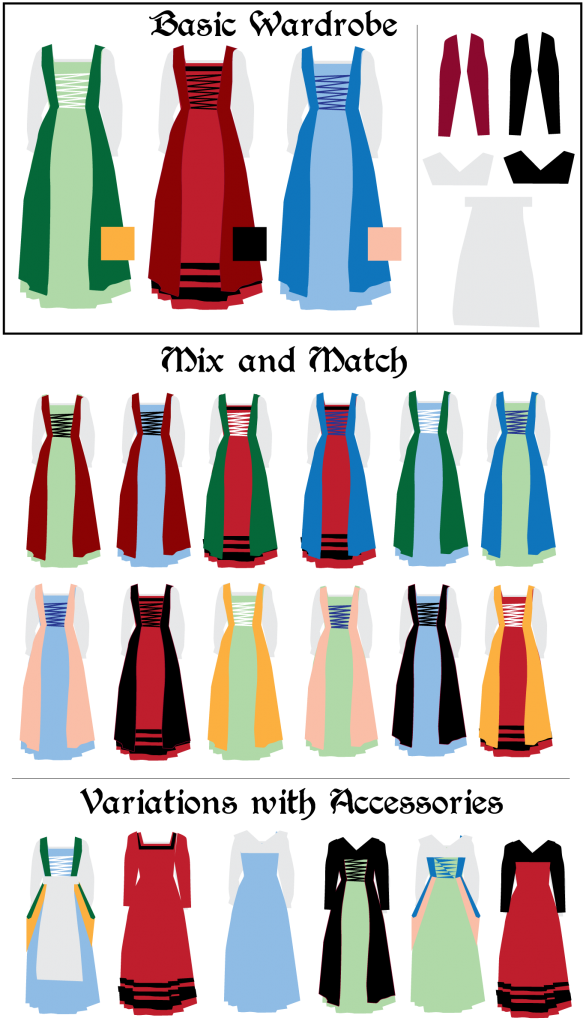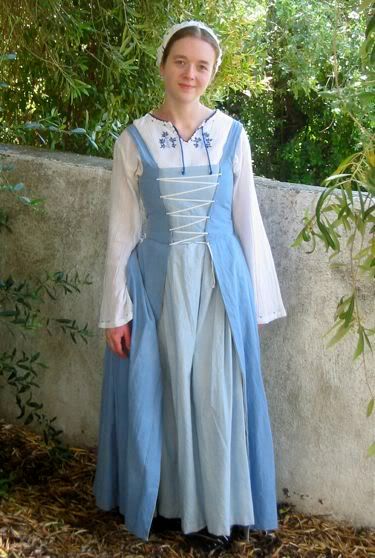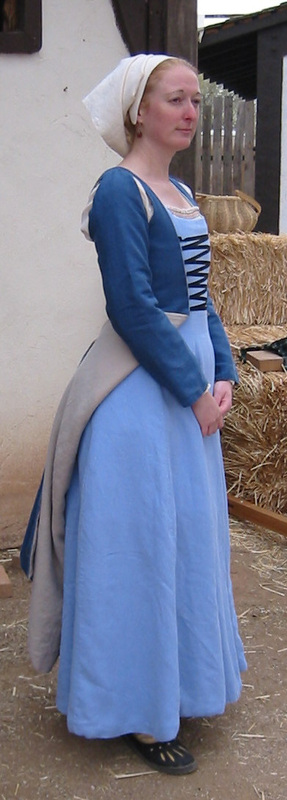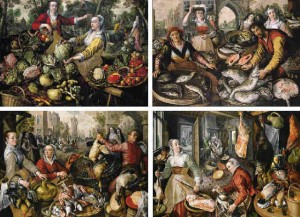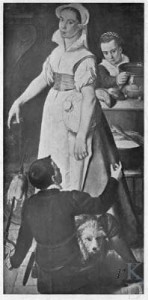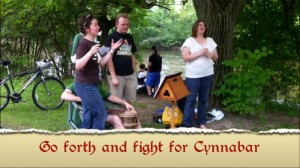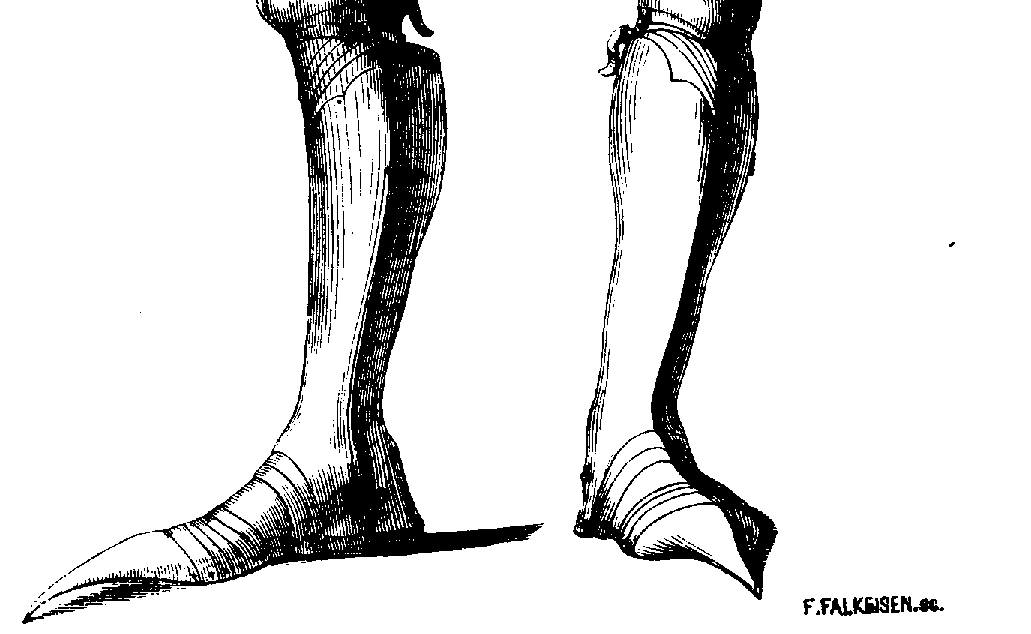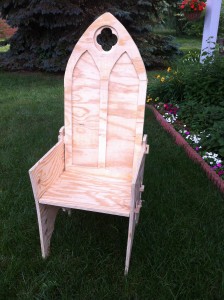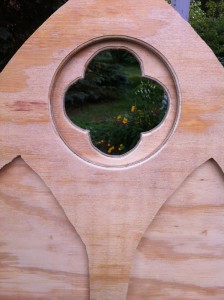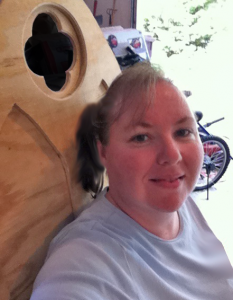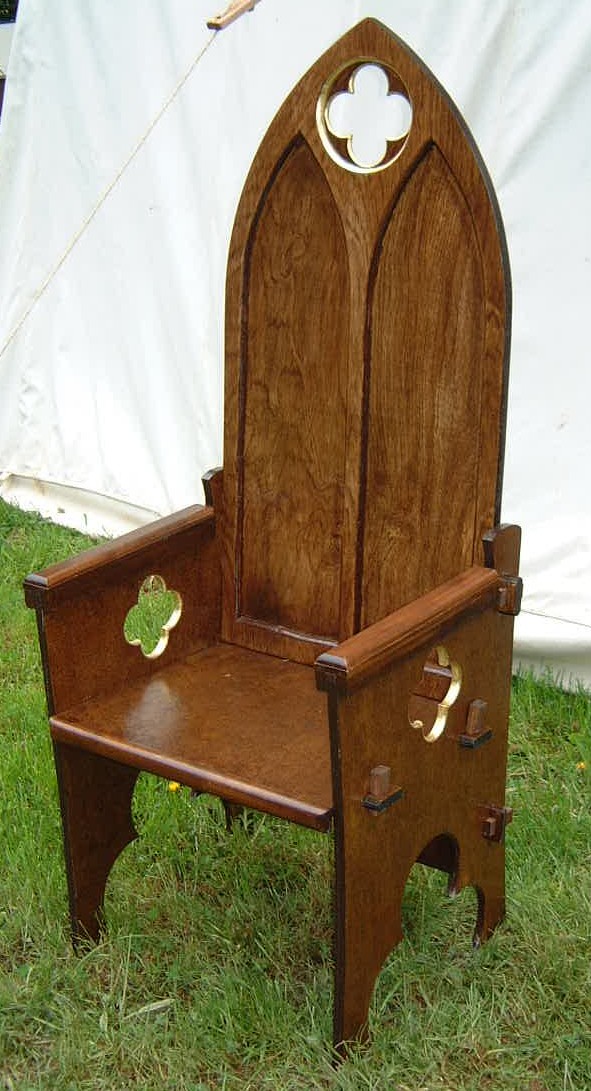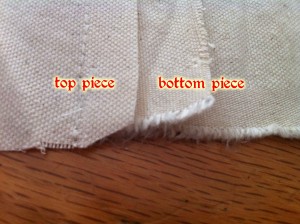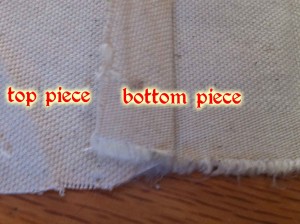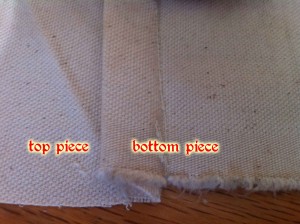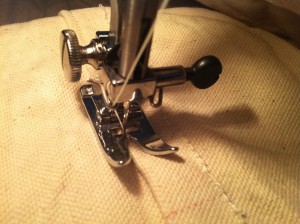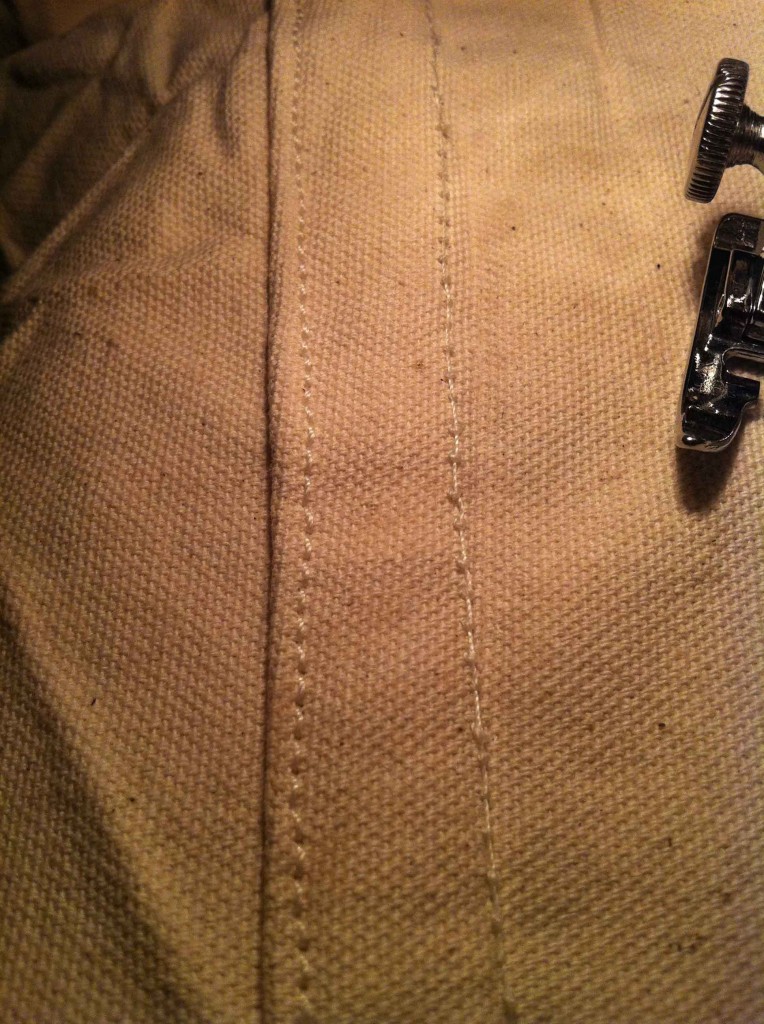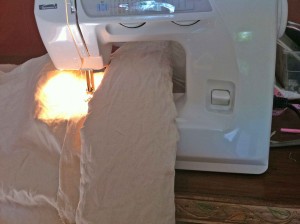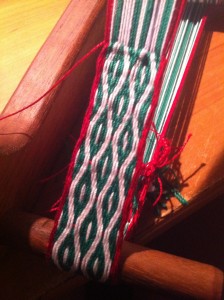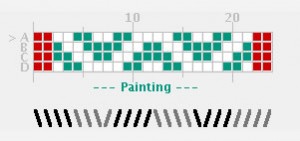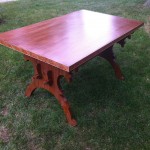
My Trestle Table
If you’re prone to dancing on tables, read no further. But if you want an authentic-looking, wooden trestle table that you can take to events, or even use as a craft table in your home, do I have some woodworking plans for you! You won’t be able to dance on this table, sure, but its lightweight tabletop is perfect for lugging about without breaking your back … or your wallet!
How did these plans come about? In 2011 I joined the SCA and I needed a table for camping at Pennsic, but I didn’t want to spend a fortune on it. I could buy a couple sheets of plywood, but I want to use this table year-round for crafts, so I preferred something that would look nicer. Alas, oak and even select pine is really pricey — $100 and up for the project. My solution? I combined an old recycled door (for the table top) with inexpensive pine (for the legs and spacers) for a 15th-century, St. Jerome-style trestle table that comes in at under $35.
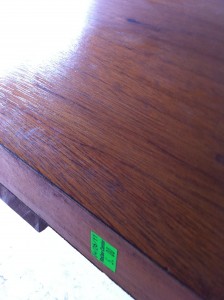
An Old Door for $5
What You Need:
- 10 feet of 2″ x 4″ pine – $3
- 10 feet of 2″ x 12″ pine – $10
- 8 feet of 2″ x 10″ pine – $7
- 1 36″ x 80″ hollow door slab – $5 at my local recycling center (or about $30 if you buy one new at Lowe’s)
- Dowels- $1
- 4 (four) 1″x 2″ x 8″ firring strips – $3.20
- 1 12″ x 24″ x 1/2″ oak board – $3
- Wood glue – $2
Total for the Table: $34.20
Optional Extras to Make Your Table Fancier:
- Stain (Minwax Polyshades Antique Walnut Gloss) – $12
- Moulding to put around the table edges – $20
- Wood burning tool to make designs – $12
Equipment Used:
Jigsaw, circular saw, drill with boring bit, sander, chisel, mallet, pipe clamp, spring clamps, sawhorse, ruler, knife, permanent marker, safety goggles
Experience Required:
I’d say beginner-intermediate. I’ve only made a few things from wood (some benches, a two-step stair, some trellises), and I was able to create this table to my satisfaction.
So you may be wondering what in the Known World possessed me to use an old recycled door as a tabletop. I thought a door would be both inexpensive and light enough for me to carry on my own. I can’t very well use this table at Pennsic if I can’t even carry the tabletop to my camp site, now can I? A hollow door slab is really quite lightweight, but still strong enough to function as a great table. It’s true, no table dancing, but how often does that really happen anyway (oh, right, I’m going to Pennsic … )
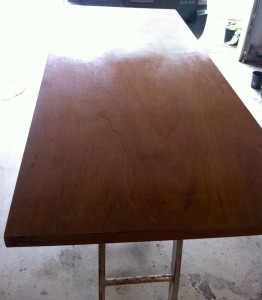
A door is the perfect size for a trestle table
As for finding an old door, my local recycling center had about 50 of ’em, all for $5-$10. I was able to find one that hadn’t ever had a door handle installed, too. And it was already stained a good color. Just needed a little dusting! You might have one hanging around the house from a remodel (or know someone who does). And I’m convinced that doing something like this is period — our ancestors recycled wood, including old doors, whenever it made sense. Wood was never wasted.
As to whether you can actually use a hollow door slab as a tabletop, yes, you can! This is a common practice among folks who need furniture on a budget, model train enthusiasts who need a place for their layouts, drafters who need a desk, and crafters who want a large workspace.
The Table Plans
So here’s how to make the trestle table — these plans are adapted from those posted by Charles Oakley and bits and pieces picked up from other online sources.
1. Join the Leg Pieces: Cut the 2″ x 12″ board into four 30″ long pieces. Cut the 2″ x 10″ board into two 30″ long pieces. Place one of the 2″ x 10″ boards on the floor or some other flat place, and flank it with two of the 2″ x 12″ boards, creating 34″ x 30″ of wood. Repeat with the other three boards. Drill holes in the edges of the boards where they meet, then insert dowels into them and glue them in place with wood clue. Clamp and allow to dry for 24 hours.
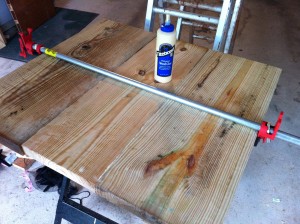
Join the wood tightly and securely
2. Size the Tabletop (Optional): If you want to use the full length of your door slab, just skip this step. I wanted my table to fit into a free space in my studio so I could use it as a craft table, however, so I’m shortening my door slab. Here’s how to do it: Measure 58″ inches on your door slab and score it with a knife (this prevents splintering when we cut it). Cut the door so it is 58″ long (I used a circulate saw). [Note: You can vary the length of your table, but be sure to change the length of your stretchers in step 3 accordingly.] Make room in the newly open end by pulling out/pushing in the reinforcements you’ll find there. Cut your firring strips to about 34″ long and place them just inside the open end of the door for support on the end, using wood glue to keep the strips in place. Clamp and allow to dry.
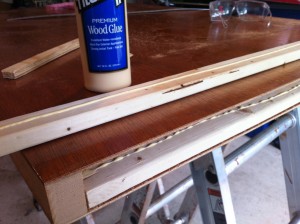
Plug the open end of your hollow door with strips of wood and glue
3. Create the Stretchers: Take the 2″ x 4″ and cut into two 51″ lengths (shorten or lengthen this if you have a shorter or longer table than me). Trim the end of each spacer according to the diagram below. To create the mortise (the hole in the end of the stretcher), use a boring bit on your drill to drill in two places (either end of the bit of wood you want to remove), then use a jigsaw and/or chisel to remove the extra wood and smooth it down.
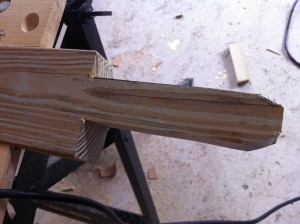
Cutting the ends of the stretchers
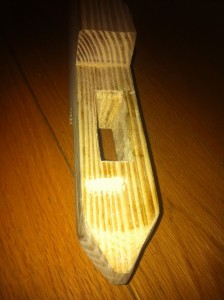
Mortise in the end of a stretcher
4. Create the tenon keys. The tenon key is the tapered bit of wood that will fit into the mortise and hold the legs and stretchers in place). You need four of them. Use the oak board (or just leftover pine) and cut the board into two 4″ x 7″ x 1/2″ pieces, then cut each of those boards diagonally in half and round the ends. Each key should be 1″ at the bottom and about 3″ at the top. You can this diagram (PDF file) to cut your tenon keys: trestle-table-tenon-key.pdf
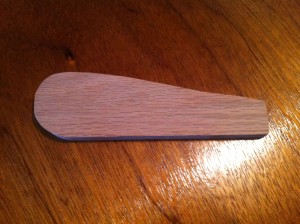
One of the tenon keys
5. Cut away the extra wood in your table legs once the wood glue has dried (wait at least 24 hours). Here is the diagram I used for my table legs. I drew the pattern in Adobe Illustrator, printed it out tiled, taped the pages together, cut it out, and drew the pattern onto my wood. Just flip the pattern over to do the other side of the wood. Here’s the pattern I used in a PDF: trestle-table-leg-design.pdf
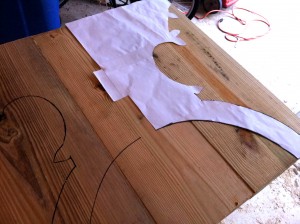
Marking my pattern on the wood
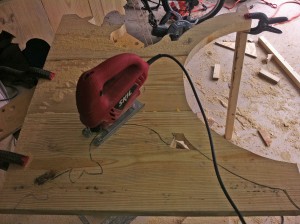
Cutting out the design on the legs
6. Assemble your table legs, stretchers, and tenons. Now that everything is cut out, put your table legs and stretchers together. You may find that some tenons don’t quite fit in some mortises, and now is the time to narrow/widen as necessary. Once it’s all put together just the way you like, take a permanent marker and write indicators on each board so you now how to assemble it quickly and easily next time.
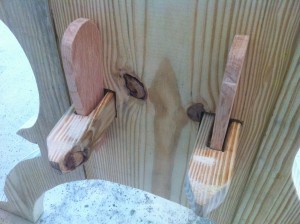
Assembled legs with tenons firmly wedged in mortices
7. Attach tabletop anchors. As the tabletop is so light, I want to avoid actually attaching the tabletop to the legs, just in case the legs were a bit too heavy for it when it was picked up or otherwise moved. So I attached simple 1″ x 2″ boards to the underside of the table, on either side of where the legs meet the table, to hold the table in place and prevent it from moving about when used. I attached the boards to the very sides of the door, where it is solid, for the most secure hold — and this has the added advantage of strengthening the underside of the door a bit. Now the tabletop just rests on top of the legs, but doesn’t slide or move thanks to the anchor boards. (Note: If I find the tabletop moves or tilts during use, I’ll simple drill holes through the anchor boards and into the top of the legs, then slip a dowel through for stability.)
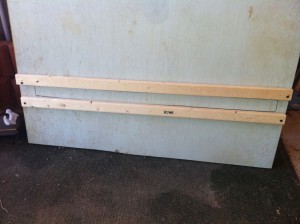
Anchor boards attached to the underside of the door/tabletop
And that’s it … the table is done!
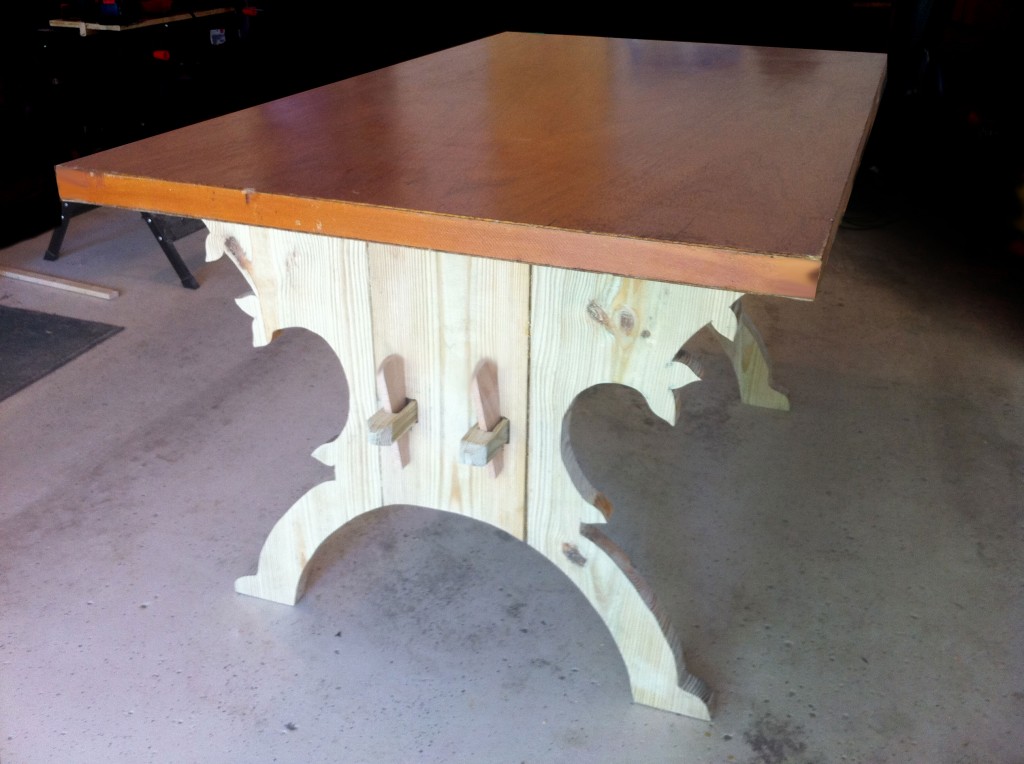
A functional trestle table for under $35!
Now you can fancy it up, if you like. Since I’d saved so much in the construction of the table, I decided to put moulding around the edges and stain the moulding, legs, stretchers, and tenons. That cost an extra $32, although I’d already bought the stain for another purpose (my cooler cooler and my benches). Here is my completed table:
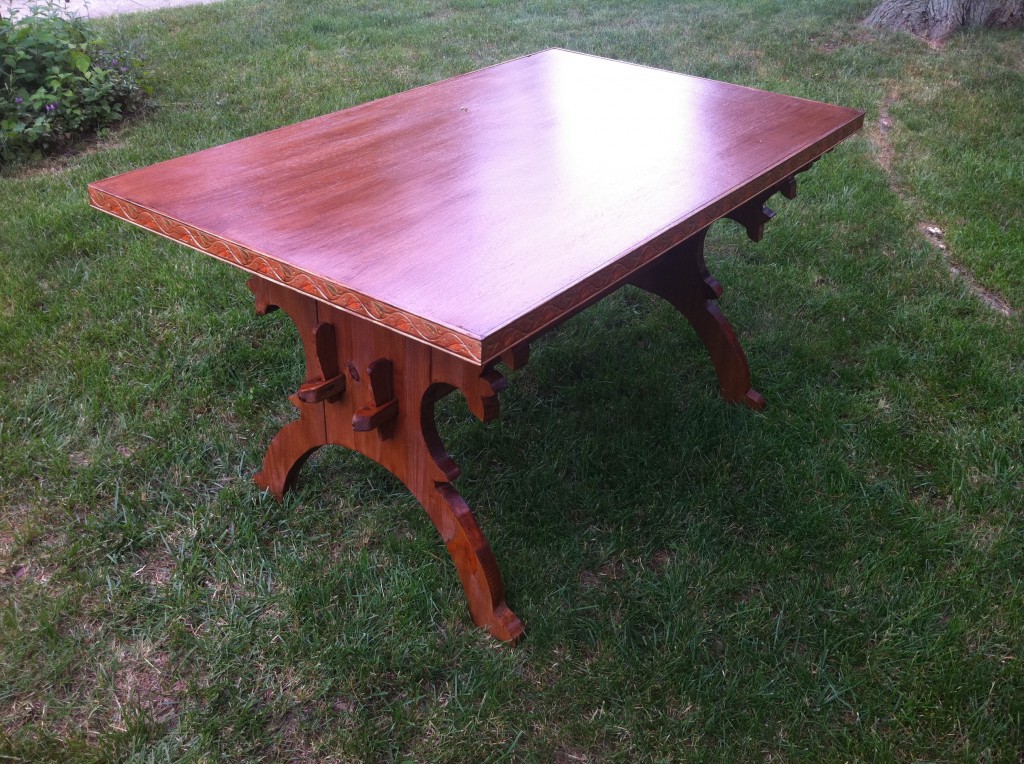
My inexpensive but lovely trestle table
Tips I Learned the Hard Way:
- Buy dry wood. Wet wood is super heavy and hard to cut! And it won’t take any stain until it dries anyway.
- If possible, smooth or otherwise plane the sides of the wood boards before you dowel and glue them together in step 1. This will really help the boards stay strong and stable.
- When you apply any wood glue, put glue on all surfaces to be glued in a thin, even coat. And clean up any wood glue that beads or globs during the drying process — it’s really hard to get this glue off once it has dried.
- When staining with tinted polyurethane like I did, keep a cloth handy to wipe drips — it gets tacky VERY FAST and is hard to wipe up later. Also, do not go back over previously stained areas (anything older than, say, 3 minutes) until it is absolutely dry because it will glob and gunk and look yucky. This happened with mine, and I got better at the staining thing as I went along (told you I wasn’t that experienced!)
All comments, questions, and suggestions for improvements most welcome!
Also, it’s probably not clear who wrote and made this table, but it was me (Genoveva), working on my own. Gregor was in another state at the time! He’s since helped with many other projects, but not this particular one.
Update 2/2014: This table continues to serve us very well and has survived six weeks at Pennsic so far. I am glad I used a hollow core door, especially now that we have quite a bit of stuff to bring to Pennsic and weight is an issue. The table gets near daily use at home, too, as my sewing table. Here are photos of the table in action:
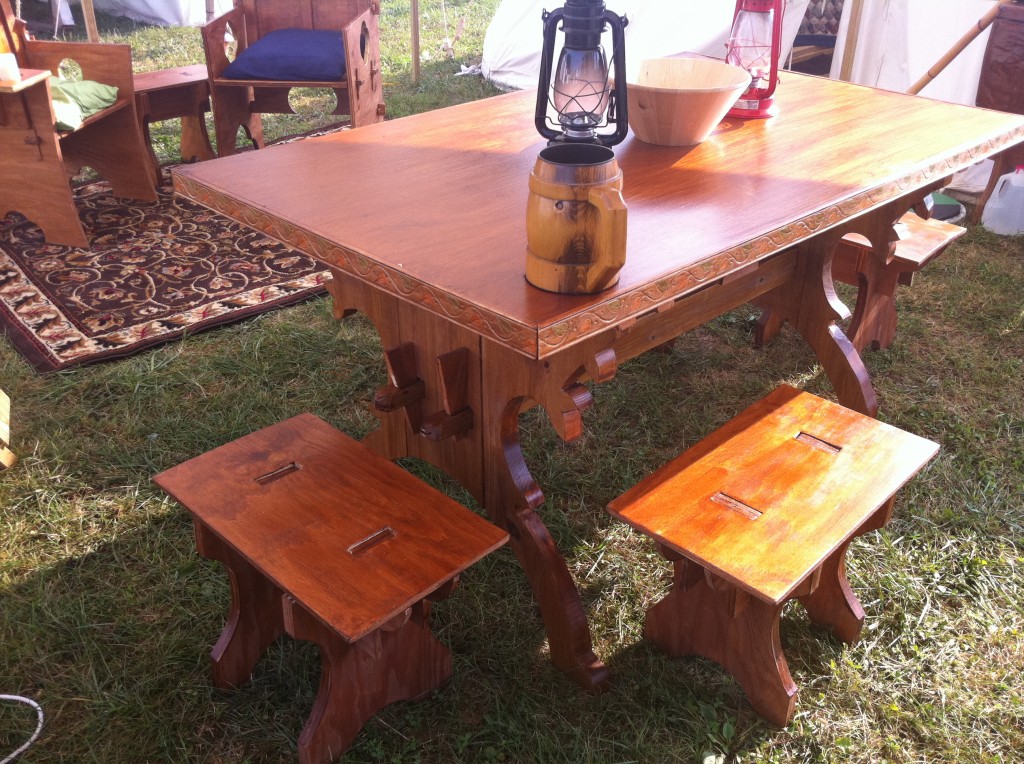
Our table at Pennsic 40
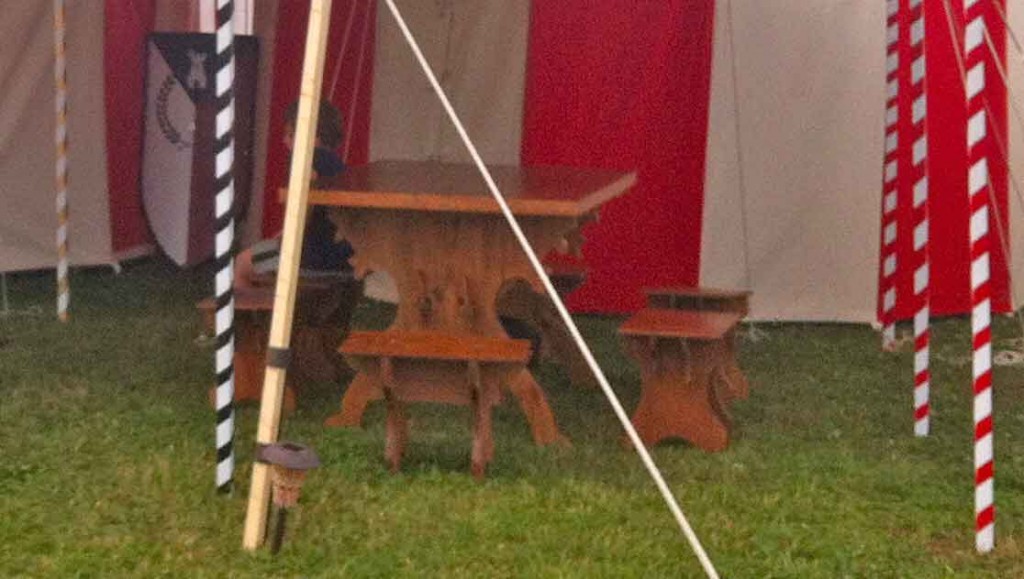
Table at Pennsic 41
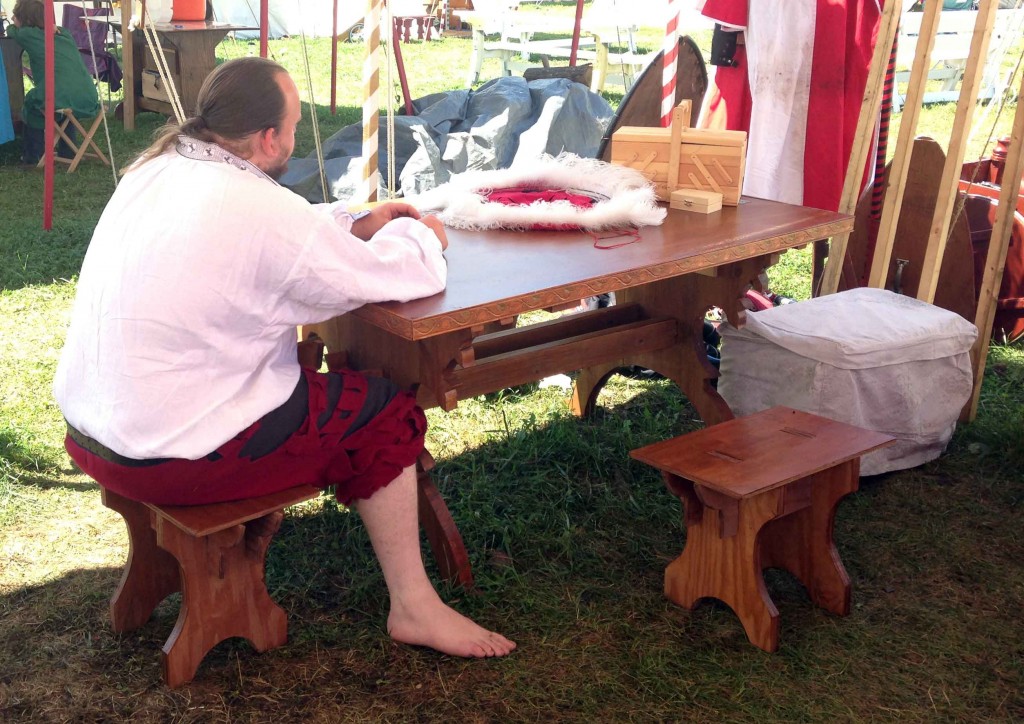
Table at Pennsic 42
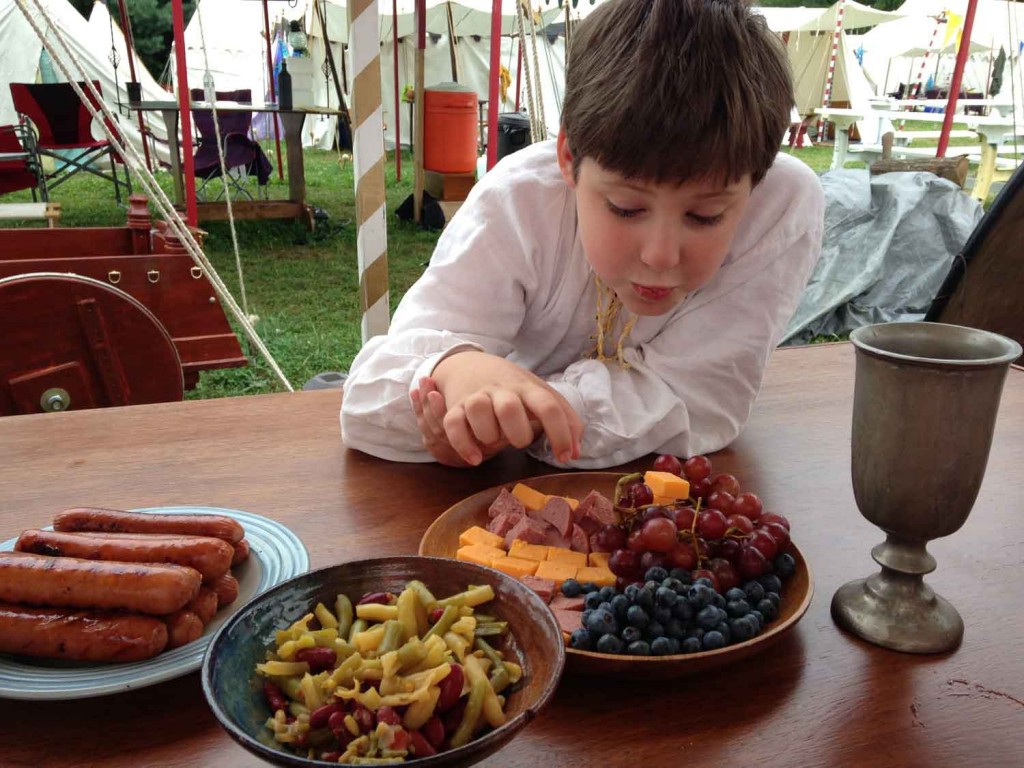
Our table gets a lot of use!
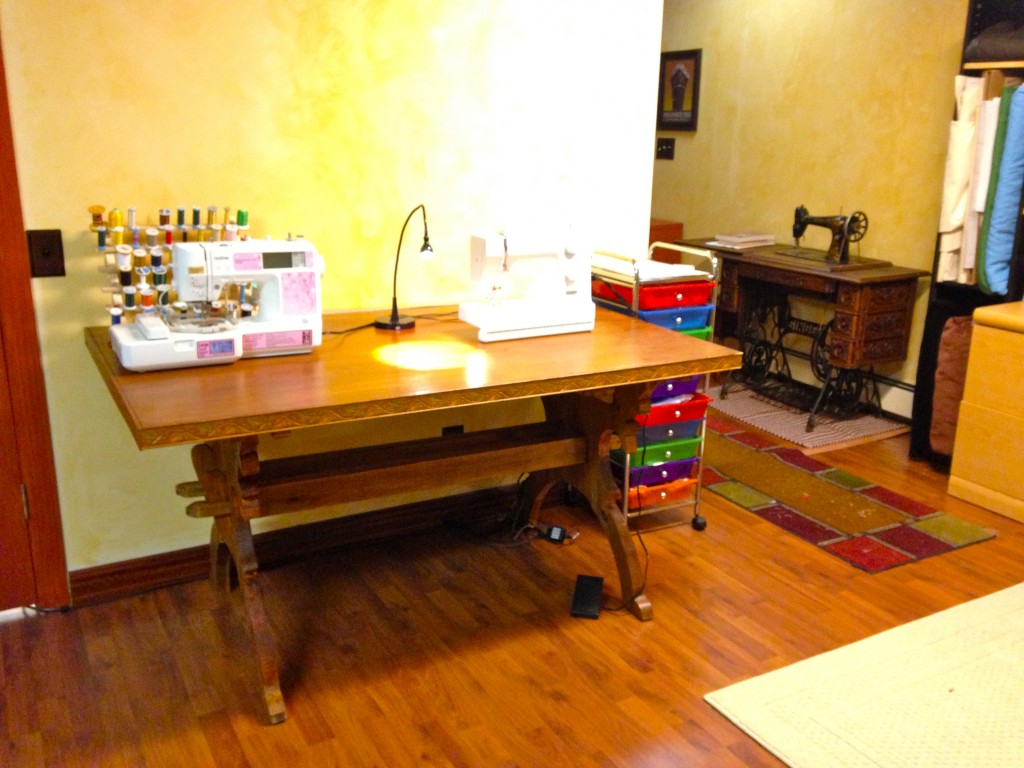
My table functions as a sewing table at home most of the time
And we’re planning to bring it to Pennsic 43! And if you’re interested in camp furniture, check out these other things we made:

